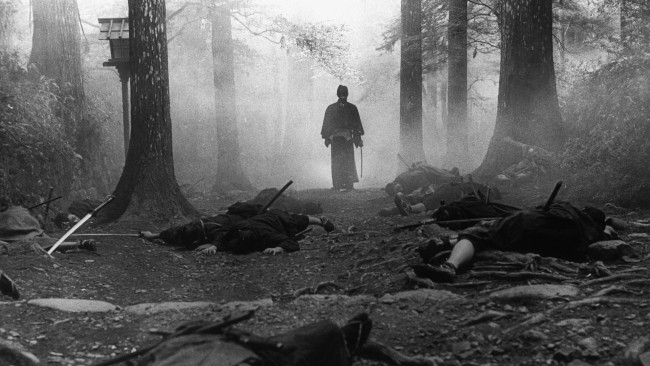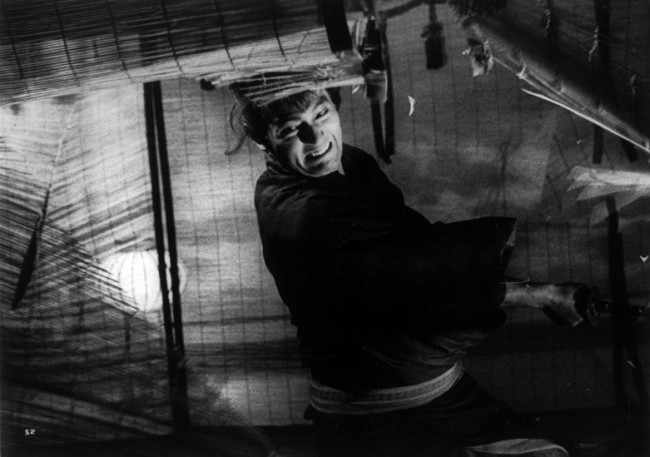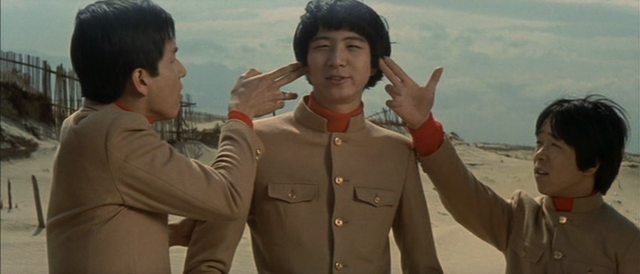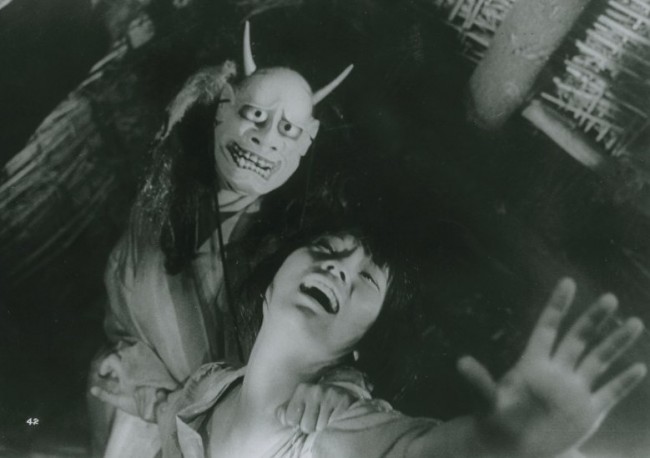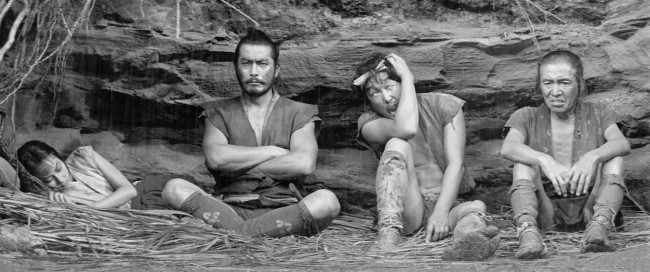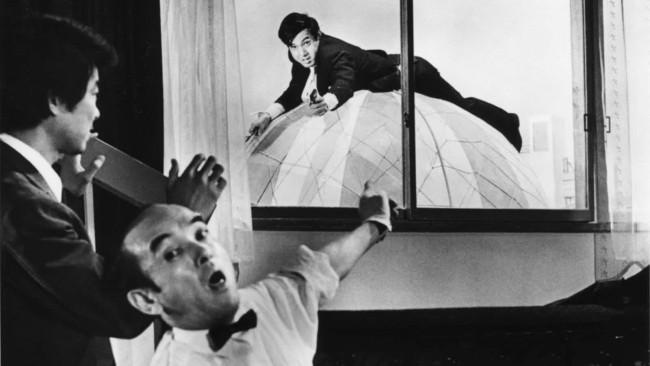By Mikhail Karadimov March 2nd, 2016
An obsession has taken hold of me. Nothing disorienting, nothing that questions the severity of my health. All the same, it’s an obsession. Japanese films from the ‘50s to—and through—the ‘70s. Can’t get enough of them. They transport me as movies should, to a land of black and white codes, of samurais and gangsters, of people tethered by vendetta, by rage, by apocalypse. This is a post-WWII world, a post-apocalyptic world. Bombs have dropped, people have died, and discipline and integrity and honor have come into question. Subversion is key, but so are ideals, and whether or not its possible to hold onto those ideals. This is what I’ve been watching, the films of Seijun Suzuki, Nagisa Oshima, Kihachi Okamoto, their stories, their politics, their wild subversions.
Mind you, what I know of Japanese film, of what I’ve watched, is the opposite of comprehensive. I am a full-blown rube. It’s only recently that I’ve grown mad in my consumption of the Japanese must-sees. It all started with a promise to my cousin from Odessa that we would have a movie night once a week. I have been troubled by her inclusion into my movie-going life. She’s only been here for some two years and every chance I’ve gotten I’ve taken her to the movies, under the impression that her tastes tend toward lighter fare, YA fare, Star Wars and Marvel. Alas, I was wrong. I tortured and dragged her through screenings of Hunger Games, The Avengers, and (sigh…) Mad Max: Fury Road before realizing my error. She could barely stand any of them. It wasn’t till recently that I realized how off the mark I was. The girl likes her fair share of art house, too, especially Japanese film.
So, here I am, without much of a point, only to say that I love Japanese film.
And now, getting that belabored preface out of the way, I would like to share with you my five favorite Japanese films from my January and February movie nights. Mind you, I’ve seen somewhere between fifteen and twenty Japanese films these last two months, and I have either liked or loved most of them. These, however, are the five that made the biggest impact.
And without further ado, and in no particular order, here are those five films:
The Sword of Doom (1966) d. Kihachi Okamoto
Leading up to my commitment to explore Japanese film in its entirety, my main diet of Japanese cinema consisted of large helpings of Akira Kurosawa. And if you know Kurosawa then you know the man’s preoccupation with honor and codes and keeping to your word, defending the little man, sacrificing one’s self for justice, committing to shame and seppuku when you’re name and reputation has been tarnished. Rigorous stuff. You see, Okamoto isn’t as interested in all that. Neither is his “hero”—or rather: anti-hero—Ryunosuke Tsuke, played by the brilliant Tatsuya Nakadai. Ryunosuke kills like its his sole mission. He kills as if he were the grim reaper and it was his duty to see you through your bloody death, which, of course, acts as antithesis to everything Kurosawa has ever preached in his own films: sensible murder, justified murder. Mind you, it’s a subversion that is further accentuated by Kurosawa-regular Toshiro Mifune’s presence. Mifune, arguably, is the bigger star of the two, and his face, his characters of Kurosawa past, have come to represent something like an ideal that both Nakadai and Okamoto obliterate with great glee. This movie is pure character study; it is the depiction of a man’s descent into the netherworld and his bloody journey to get there.
Also worth noting: the film’s final scene is one of blissful carnage. Not since I’ve seen Kill Bill Vol. I (03) in theaters have I witnessed mayhem so kinetic, so delirious. And still, Tarantino has nothing on Okamaoto’s denouement, not when it comes to the climactic battle’s pounding sense of dread and doom. You get the sense that, if no one stops Ryunosuke, the world will one day burn at his feet.
Three Resurrected Drunkards (1968) d. Nagisa Oshima
Not necessarily my favorite Oshima movie, but certainly one of his strangest and most experimental. Time matters not a wink in this film. Oshima bends and welds temporal logic into an inverted pretzel. Honestly, the film reminds me of A Hard Days Night (64) by way of Japanese New Wave. The gags are somewhat sketchy in their delivery, silly even, whacky in a cartoonish way, all of which is ultimately balanced out by Oshima’s obscured message on Japan’s relations—back then—with Korea.
This is where Oshima’s distinction as one of the Japanese New Wave’s greatest comes through—in his technique. You will see a lot of similarities to Godard and his merry band of New Wave pranksters over in France. Quick cutting, jagged cutting, with an artificiality that never relents on its brazen proclamation: I AM MOVIE! HEAR ME ROAR! This is good, meta fun, and one of Oshima’s least discussed films, one of his underdogs. Sure, In the Realm of the Senses (76) is a powerful film, but it’s a lot more accessible in its pretensions than Drunkards or Japanese Summer: Double Suicide (67) or any of his other ‘60s efforts. This is when Oshima was purely Japanese, esoteric even; this is before he hits the scene as an “international auteur” with the aforementioned In the Realm of the Senses. In fact, other than his final film, Gohatto (99), Oshima filmed all his “international” efforts outside of Japan.
Onibaba (1964) d. Kaneto Shindo
Japanese directors sure love waxing poetic on the topic of self-entrapment. Plenty of this movie reminds me of the claustrophobic sweatiness of Teshigahara’s Woman in the Dunes (64). These people have all chosen self-exile; they have chosen the insurmountable rage of nature over the brick-and-concrete complacency of the city, and because of it they see their baser sides come out crashing, churning, foaming only to recede again into the endless depths of acquiescence.
This film is beyond mesmerizing. I could have easily withdrawn myself from society and watched a looped reel of Shindo’s lovingly rendered shots of reeds blowing in the wind, rippling out, lashing out, in smooth undulations, like a tempest-battered ocean. But aside from the mesmerizing cinematography, there’s the coarseness of story, too: two women, both waiting for a certain man to return—a son, a husband—sustain themselves with the dirty business of ambushing and murdering samurai on the run, stripping them of their precious materials, and then dragging them off to a hole lost in the middle of the reeds. This film refuses to pull punches. These aren’t pleasant women, but hungry women. They want touch, they want company. They’re desperate for it and are willing to do whatever, no matter the demonic cost, of retaining that company. But, at the same time, Shindo doesn’t skimp on the empathy. He shows us the tinkering of motivation, the origins of thoughts; he shows the fear that breads paranoia, loneliness, desperation. We understand how his characters swerve from point A to point Z, how they come to their selfish conclusions.
Doesn’t hurt that the movie is sexy and grimy all at once, and totally visceral when it comes to the ensemble’s subjected form of living, how they habituate to their circumstances. Once the samurai are away, out in the field of combat, earning their honor and posterity through bloodshed, the rest of civilization is at home fending off starving bellies, tyrant pawnbrokers, lascivious neighbors, but without the honor, without the solace of a straight posture, of a puffed chest, of claims to heroism.
Survival is survival, no heroes or villains in that game.
The Hidden Fortress (1958) d. Akira Kurosawa
This one came up with something like expectations. However, I wouldn’t say that they were high expectations. Nor low. Nothing like that. Just expectations. Regular expectations. Or rather: it came with a reputation as a known model for another, much more popular film.
Of course, most film buffs already know that George Lucas, the originator of the Star Wars franchise, copped heavily from Kurosawa’s Hidden Fortress when cobbling together the structure for a New Hope (77). I’ve never been a fan of the Star Wars franchise, but I’ve never been a hater either. To me the franchise simply exists, the same way the Spider-Man franchise exists. It simply is, rather than is not.
That being said, it was fun watching Hidden Fortress with Nastya—my cousin—and doing our best to point out all the potential homages, the character parallels, the echoing plot beats, etc. It was like a film nerd’s version of Where’s Waldo?
That being said, I can’t think of a Kurosawa movie less pretentious, less didactic, and more fun than Hidden Fortress. Mind you, this is far from my favorite Kurosawa—that prestigious place in my heart belongs to the brilliant Fincher-like procedural, High and Low (63).
The film is flat out funny, deriving most of its comic relief from the inspiration for R2D2 and C-3PO: Tahei and Matashichi. The groans and yelps they illicit, the ceaseless bitching and high-shrieked laments of poverty and pain, their cowardly reflex to jump and run at the slightest sign of provocation, their subservience to Mifune’s General Makabe as they call him “boss” whenever they are lost or afraid, their senseless greed, it all tickled me funny. What made it even funnier was my cousin’s straight-up disdain for the two bedraggled peasants. Knowing how much they made her squirm with irritation whenever they showed their greed or their lack of duty, made me laugh all the harder whenever they appeared on screen with their old antics.
But it’s not just the comedy that won me over. The action was superb. Some of Kurosawa’s best. Especially when it came to the showdown between Makabe and his rival general Tadokoro. They exchange their katanas for long spear-like weapons and duel with great precision and breath-taking choreography. These men swing at each other with full force, ducking and dodging, evading at all costs the shattering blow of that long length of wood and blade. There were no stunt men here. Most of the fight was shot in full and wide takes that ran longer than usual. There was no cheating the fight.
All in all, the film is great, rudimentary fun. There’s no higher notion to anchor it with stilted dread or quote/unquote nuance. It is what it is and doesn’t aim to be anything higher than that: an adventure story. A jaunt, but a very well crafted one.
In my opinion: much better than anything produced by the Star Wars franchise. Maybe Lucas should have studied Kurosawa and his filmography just a wee bit more before setting pen to paper on A New Hope.
Branded to Kill (1967) d. Seijun Suzuki
Oh, Jo…. How can you say no to those cheeks? It all lies in those cheeks. I don’t think there’s a more perfect face for Suzuki’s deconstruction of the Japanese gangster picture than that of Jo Shishido’s. His cheeks, coupled with those overly styled sunglasses, so perfectly reflect the flagrant disrespect Suzuki held for the Japanese gangster picture, specifically the Nikkatsu Company’s gangster pictures. As well as their slave-like production line, their cheapness, their overall nasty attitude toward Suzuki and his efforts. This is supposed to be Suzuki’s tough man? Good ol’ Jo? His number three assassin? This cartoon?
Suzuki was clearly fed up at this point with the Nikkatsu Company. He was tired of playing second fiddle to “bigger” named directors like Kenji Mizoguchi whose films always played as the top-tiered shows of a double bill, while Suzuki’s were relegated to “B-movie” hell. The Nikkatsu Company couldn’t stand Suzuki’s films—the way he would fuck around with form—and so they constantly threatened him with budget slashes and mediocre scripts. Branded to Kill was in fact Suzukui’s ballsy response to the studio’s decision to saddle him with yet another generic gangster picture about something or another.
Branded to Kill is Suzuki’s middle finger to the system; it’s his infinite joke. The movie is scarcely serious, or rather, scarcely real or grounded. It’s about a hit man possessed by the scent of freshly boiled rice, a hit man with cartoonishly ballooned chipmunk cheeks, who is determined to see a rise in his ranking as the number three assassin in Japan. This is all he cares about, all he drives toward: to rise to number one. The film’s a blatant fart in the face of Nikkatsu’s executives, especially studio president, Kyusaku Hori, and its glee for anarchy is deliriously infectious.
* * * * *
Hope you enjoyed the recommendations. I’ll be back in a couple of months, maybe sooner, with a new list of Japanese flicks to check out. Until then, keep on the look out for potential essays on more specific topics and aims. I’m looking forward to exploring, in more depth, individual films and performances, maybe even scenes, directors’ filmographies and the overarching themes and motifs of their careers. All Japanese based.
So, if you’re obsessed as I am with Japanese film, keep a steady eye, stay alert, and wait for the coming whistle of my swinging katana of film criticism.
(And yes, I’m well aware of the lameness of that last line but…oh well).
Join the Conversation on Twitter


